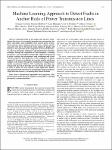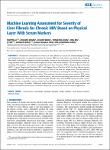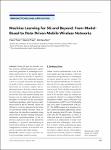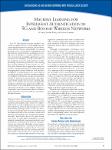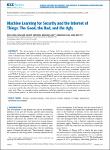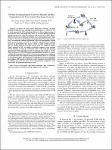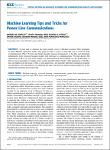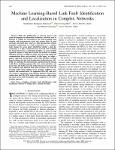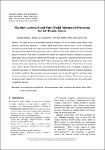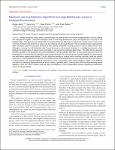- BB
Authors: Decaro, C.; Advisor: -; Participants: Montanari, G.B.; Molinari, R.; Gilberti, A.; Bagnoli, D.; Bianconi, M.; Bellanca, G. (2019) - Objective: This paper shows the application of machine learning techniques to predict hematic parameters using blood visible spectra during ex-vivo treatments. Methods: A spectroscopic setup was prepared for acquisition of blood absorbance spectrum and tested in an operational environment. This setup is non invasive and can be applied during dialysis sessions. A support vector machine and an arti cial neural network, trained with a dataset of spectra, have been implemented for the prediction of hematocrit and oxygen saturation. Results & Conclusion: Results of different machine learning algorithms are compared, showing that support vector machine is the best technique for the predicti...
|
- BB
Authors: Barbosa, D. C. P.; Advisor: -; Participants: Medeiros, L. H. A.; Melo, M. T.; Novo, L. R. G. da Silva Lourenço; Coutinho, M. d. S.; Alves, M. M.; Neto, H. B. D. T. Lott; Gama, P. H. R. P.; Santos, R. G. M. dos; Tarragô, V. L. (2019) - Detecting faults on the anchor rods of power transmission line towers is an essential procedure for guaranteeing the safety, operability, and availability of the electric power system. Such a measure aims to minimize the risk of tower collapse and the associated costs due to the lack of energy, injuries to people, and damage to the reputation of the companies involved. In this letter, we report an alternative noninvasive and nondestructive detection technique through the acquisition of electromagnetic scattering parameters. A novel machine learning (ML) approach is proposed in order to achieve the advantages of such a technique and to deal with the respective drawbacks due to the comp...
|
- BB
Authors: Li, N.; Advisor: -; Participants: Zhang, J.; Wang, S.; Jiang, Y.; Ma, J.; Dong, L.; Gong, G. (2019) - Noninvasive assessment of severity of liver brosis is crucial for understanding histology and making decisions on antiviral treatment for chronic HBV in view of the associated risks of biopsy. We aimed to develop a computer-assisted assessment system for the evaluation of liver disease severity by using machine leaning classi er based on physical-layer with serum markers. The retrospective data set, including 920 patients, was used to establish Decision Tree Classi er (DTC), Random Forest Classi er (RFC), Logistic Regression Classi er (LRC), and Support Vector Classi er (SVC) for liver brosis severity assessment. Training and testing samples account for 50% of the data set, respecti...
|
- BB
Authors: Wang, T.; Advisor: -; Participants: Wang, S.; Zhou, Z. (2019) - During the past few decades, mobile wireless communications have experienced four generations of technological revolution, namely from 1G to 4G, and the deployment of the latest 5G networks is expected to
take place in 2019. One fundamental question is how we can push forward the development of mobile wireless communications while it has become an extremely complex and sophisticated system. We believe that the answer lies in the huge volumes of data produced by the network itself, and machine learning may become a key to exploit such information. In this paper, we elaborate why the conventional model-based paradigm, which has been widely proved useful in pre-5G networks, can be less...
|
- BB
Authors: Fang, H.; Advisor: -; Participants: Wang, X.; Tomasin,S. (2019) - The 5G and beyond wireless networks are critical to support diverse vertical applications by
connecting heterogeneous devices and machines, which directly increase vulnerability for various
spoofing attacks. Conventional cryptographic and physical layer authentication techniques are facing
some challenges in complex dynamic wireless environments, including significant security
overhead, low reliability, as well as difficulties in pre-designing a precise authentication model, providing
continuous protection, and learning time-varying attributes. In this article, we envision new authentication
approaches based on machine learning techniques by opportunistically leveraging physica...
|
- BB
Authors: Liang, F.; Advisor: -; Participants: Hatcher, W. G.; Liao, W.; Gao, W.; Yu, W. (2019) - The advancement of the Internet of Things (IoT) has allowed for unprecedented data collection, automation, and remote sensing and actuation, transforming autonomous systems and bringing smart command and control into numerous cyber physical systems (CPS) that our daily lives depend on. Simultaneously, dramatic improvements in machine learning and deep neural network architectures have enabled unprecedented analytical capabilities, which we see in increasingly common applications and production technologies, such as self-driving vehicles and intelligent mobile applications. Predictably, these technologies have seen rapid adoption, which has left many implementations vulnerable to threa...
|
- BB
Authors: Yang, Y.; Advisor: -; Participants: Deng, X.; He, D.; You, Y.; Song, R. (2019) - In future 5G user-centric ultra-dense networks (UUDN), demands of high data rate and high spectrum efficiency are effectively met by dual connectivity (DC) technology. However, due to huge increase of base stations (BSs) and mobile users (MUs), it becomes difficult for BSs to quickly and precisely select the codeword and provide DC to MUs. Hence, different from some traditional methods, this correspondence paper aims to improve the network performance using the method of machine learning. First, we model the random distribution of BSs by homogeneous Poisson point processes, where each MU is served by millimeter-wave channel. Second, the probabilities that macro cell BS or small cell BS...
|
- BB
Authors: Tonello, A. M.; Advisor: -; Participants: Letizia, N. A.; Righini, D.; Marcuzzi, F. (2019) - A great deal of attention has been recently given to Machine Learning (ML) techniques in many different application elds. This paper provides a vision of what ML can do in Power Line Communications (PLC). We rst and brie y describe classical formulations of the ML, and distinguish deterministic from statistical learning models with relevance to communications. We then discuss ML applications in PLC for each layer, namely, for characterization and modeling, for the development of physical layer algorithms, for media access control and networking. Finally, other applications of the PLC that can bene t from the usage of ML, as grid diagnostics, are analyzed. Illustrative numerical exam...
|
- BB
Authors: Rocha, A.; Advisor: -; Participants: Groen, T. A.; Skidmore, A. K.; Darvishzadeh, R.; Willemen, L. (2018) - This study assesses the impact of spatial autocorrelation on the generalisation of plant trait models predicted with hyperspectral data. Leaf Area Index (LAI) data generated at increasing levels of spatial dependency are used to simulate hyperspectral data using Radiative Transfer Models. Machine learning regressions to predict LAI at different levels of spatial dependency are then tuned (determining the optimum model complexity) using cross-validation as well as the NOIS method. The results show that cross-validated prediction accuracy tends to be overestimated when spatial structures present in the training data are fitted (or learned) by the model.
|
- BB
Authors: Srinivasan, S. M.; Advisor: -; Participants: Truong-Huu, T.; Gurusamy, M. (2019) - With the proliferation of network devices and rapid development in information technology, networks such as
Internet of Things are increasing in size and becoming more complex with heterogeneous wired and wireless links. In such networks, link faults may result in a link disconnection without immediate replacement or a link reconnection, e.g., a wireless node changes its access point. Identifying whether a link disconnection
or a link reconnection has occurred and localizing the failed link become a challenging problem. An active probing approach requires a long time to probe the network by sending signaling messages on different paths, thus incurring significant communication delay ...
|
- BB
Authors: Huang, H.; Advisor: -; Participants: Lin, J.; Wu, L.; Fang, B.; Wen, Z.; Sun, F. (2019) - This paper focuses on multi-modal Information Perception (IP) for Soft Robotic Hands (SRHs) using
Machine Learning (ML) algorithms. A flexible Optical Fiber-based Curvature Sensor (OFCS) is fabricated,
consisting of a Light-Emitting Diode (LED), photosensitive detector, and optical fiber. Bending the roughened optical fiber generates lower light intensity, which reflecting the curvature of the soft finger. Together with the curvature and pressure information, multi-modal IP is performed to improve the recognition accuracy. Recognitions of gesture, object shape, size, and weight are implemented with multiple ML approaches, including the Supervised Learning Algorithms (SLAs) of K-Nearest N...
|
- BB
Authors: Leonita, G.; Advisor: -; Participants: Kuffer, M.; Sliuzas, R. V.; Persello, C. (2018) - Results show that local acceptance for a remote sensing-based slum mapping approach varies among stakeholder groups. Therefore, a locally adapted framework is required to combine ground surveys with robust and consistent machine learning methods, for being able to deal with big data, and to allow the rapid extraction of consistent information on the dynamics of slums at a large scale.
|
- BB
Authors: Alimi, R.; Advisor: -; Participants: Ivry, A.; Fisher, E.; Weiss, E. (2019) - Modern magnetic sensor arrays conventionally use state-of-the-art low-power magnetometers such as parallel
and orthogonal fluxgates. Low-power fluxgates tend to have large Barkhausen jumps that appear as a dc jump in the fluxgate output. This phenomenon deteriorates the signal fidelity and effectively increases the internal sensor noise. Even if sensors that are more prone to dc jumps can be screened out during production, the conventional noise measurement does not always catch the dc jumps because of their sparsity. Moreover, dc jumps persist in almost all the sensor cores although at a slower but still intolerable rate. Even if dc jumps could be easily setected in a shielded environme...
|
- BB
Authors: Haas, C.; Advisor: -; Participants: Leue, M.; Ellerbrock, R.H.; Gerke, H.H. (2020) - The spatial distribution of dye concentrations was visualized and quantified with a fluorescence imaging technique at a pixel resolution length of ∼100 μm. Submillimeter‐scaled distribution maps of adsorbed dye concentrations were derived using the calibrated Freundlich adsorption model. The sorption isotherm predicted that most of the dye was adsorbed to soil. In total, 1,366 μg of dye was transferred through the coated matrix block, of which 1,181 μg was adsorbed to soil. The applicability of the method was validated by comparing applied and recovered Na‐fluorescein masses, which corresponded relatively closely. Although the test of the approach presented here was limited by uncerta...
|
- BB
Authors: Merz, S.; Advisor: -; Participants: Balcom, B.J.; Enjilela, R.; Vanderborght, J.; Rothfuss, Y.; Vereecken, H.; Pohlmeier, A. (2018) - Evaporation from bare soil surfaces can be restrained to a great extent with the development of a dry layer at the soil surface where capillary hydraulic conductance ceases and water flow proceeds only by gas phase transport. Model calculations and preliminary experiments with model porous media have shown that this surface layer can be very thin. An accurate characterization of these processes is required, which is provided by noninvasive magnetic resonance (MR) methods. The evaporative drying of a silt loam and a sandy loam was monitored at high spatial resolution in laboratory experiments. The MR data were used to assess the performance of two numerical models: (i) the Richards equ...
|
- BB
Authors: Tao, R.; Advisor: -; Participants: Zhang, S.; Huang, X.; Tao, M.; Ma, J.; Ma, S.; Zhang, C.; Zhang, T.; Tang, F.; Lu, J.; Shen, C.; Xie, X. (2019) - Objective: This study focused on developing a fast and accurate automatic ischemic heart disease
detection/localization methodology. Methods: Twavewas segmented from averaged Magnetocardiography (MCG)
recordings and 164 features were subsequently extracted. These features were categorized into three groups: time domain features, frequency domain features, and informa-tion theory features. Next, we compared different machine learning classifiers including: k-nearest neighbor, decision tree, support vector machine (SVM), and XGBoost. To identify ischemia heart disease (IHD) case, we selected three classifiers with best performance and applied model ensemble to average results. All 164 f...
|
- BB
Authors: Qi, M.; Advisor: -; Participants: - (2017) - Spartinaspp. (cordgrasses) often dominates intertidal mudflats and/or low marshes. The land-ward invasion of these species was typically thought to be restrained by low tidal inundation frequenciesand interspecific competition. We noticed that the reported soil salinity levels in some salt marshes weremuch higher than those at the mean higher high water level, which might inhibit the landward invasion ofcordgrass. To test this possibility, we transplantedSpartina alternifloraacross an elevational gradient in aninvaded salt marsh in the Yellow River Delta National Nature Reserve, where a salt accumulation zone(i.e., salt barren) was previously observed. We found thatS. alterniflorawas ...
|
- BB
Authors: Zhao, Min; Advisor: -; Participants: - (2022) - Papillary oral pathologies are a heterogenous group. Both virus-associated and non-virus-associated, malignant and benign entities may enter the differential diagnosis. In some cases, oral papillary lesions are part of a variety of skin or systemic disorders and syndromes. It is a challenge for clinicians to identify and treat the various etiology of oral papillary lesions.
|
- BB
Authors: El Shenawy, H.M.; Advisor: -; Participants: Eldin, A.M.; Nasry, S.A. (2018) - When pain and RAE scores were compared before and after treatment, a significant lower pain score (P = 0.020) and RAE scores (P = 0.025) were observed in the steroid group than the laser group. No significant differences in pain (P = 0.333) and RAE (P = 0.06) scores were observed between both groups in the follow-up. No significant difference was seen between the improvement parameters in the two groups (P = 0.117%), although better scores were seen in the steroid group.
|
- BB
Authors: Schiller, Marcus; Advisor: -; Participants: Pilette, Marijatta; Rahlf, Björn; See, Constantin von; Gellrich, N.-C. (2020) - The study outlines the current status of ZMK and discusses what could be an important component of emergency medical care in the overall hospital context.
|


